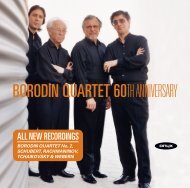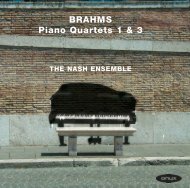Untitled - Onyx Classics
Untitled - Onyx Classics
Untitled - Onyx Classics
- No tags were found...
Create successful ePaper yourself
Turn your PDF publications into a flip-book with our unique Google optimized e-Paper software.
L’échelonnement des haies was written by Verlaine at Stickney, Lincolnshire, on a Sunday in 1875.Written after his release from prison, where he spent two years for shooting his lover Arthur Rimbaudin the arm, the poem depicts his joy at the natural beauty of the English landscape: hedges roll likewaves, trees and mills float on the grass, colts frolic. All is peace and harmony, a luminous vision ofpastoral happiness – mirrored in Debussy’s music, where the pentatonic scale depicts the pastoralscene. Verlaine left Stickney at the end of 1876 and went to live in Bournemouth, where he taughtFrench in a private school and gave French lessons to a Mr Remington. La mer est plus belle, whichoriginally bore the title ‘La mer de Bournemouth’, was published in Sagesse, and like many poems fromthat volume is concerned with seeking refuge in the Church. The poem teems with religious imagery:the sea is more majestic than cathedrals; it is also the mother of all sinners, angry yet fair; it soothesthe soul of the suffering, and gives them hope. Debussy evokes the majesty of the sea by using a floridarpeggiated accompaniment with frequent modulations that depict its changing moods. Verlaine’sLe son du cor s’afflige, an earlier poem written at the same time as Romances sans paroles, is a starkportrayal of winter: the north wind gusts, snow drifts across the red sunset, a wolf (the poet’s soul)howls, a prey to painful memories that are symbolised by the wailing horn. Debussy’s music moves frommajor to minor, and the beautiful legato of the sad melody somehow reflects the plaintive mood ofthe wintry scene. Paul Bourget (1852–1935), the poet of Beau soir, inspired no fewer than nine Debussymélodies, all during the early years of his career. The carpe diem theme is hardly original, but there is abroad sweep to the verse that clearly attracted Debussy. The melody is appropriately spacious, andthere is an expressive marking of plus lent at the end of the song to convey the imminence of death –but without sentimentality.L’Horizon chimérique was composed by Fauré in 1921, a few months only after the publication of thepoems by Jean de la Ville de Mirmont who had been killed in the Great War. All, apart from Diane,Séléné (a contemplative hymn to the moon) are seascapes, which take their rhythm from the marineimagery of the poems. Charles Panzéra, to whom the cycle is dedicated, writes in his 50 Mélodies thatJe me suis embarqué should be performed with a certain harshness, and the same might be said for allthe songs, except the gently chordal ‘Diane, Séléné’. These are not mélodies for a soft-grained voice,and Panzéra’s own complete recording of 1936 displays all the merits of his fresh, vigorous and unfussy















